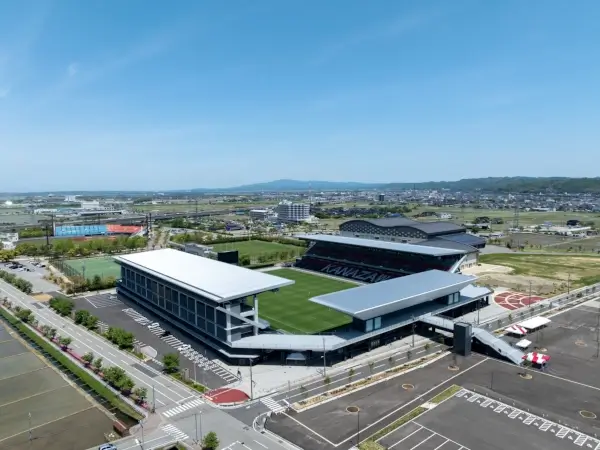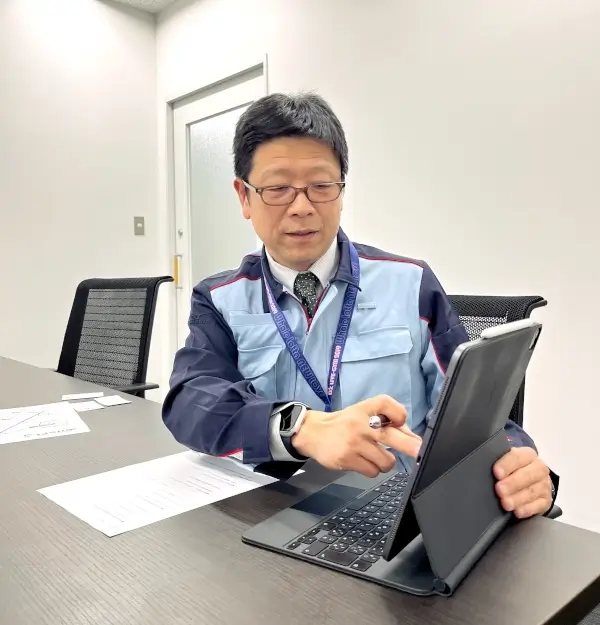Voices of MIIDEL Users

MIIDEL is active in the construction of the new stadium.
I want people who are avoiding it to try it out first!

Kumagai Gumi Co., Ltd.
Case of Hokuriku Branch

Interviewee
Kumagai Gumi Co., Ltd., Hokuriku Branch
Construction Department, Site Manager Mr. Takemoto Hiroyuki
Kumagai Gumi Co., Ltd. is a construction company originating from Hokuriku, boasting high technical capabilities with numerous cases including tunnel constructions such as the Kurobe Dam Kansai Electric Power Tunnel and Seikan Tunnel in Japan, and the construction of the world’s tallest ( at the time ) skyscraper ( Taipei 101, 508m ) abroad. This time, we talked to Mr. Takemoto, who has been using MIIDEL since 2019 and has just completed the local soccer stadium, about how he has been utilizing MIIDEL.
MIIDEL(hereafter referred to as M):Could you please tell us again about your first encounter with MIIDEL, Mr. Takemoto?
Mr. Takemoto(honorifics omitted): I had the opportunity to hear from Kyoei Sangyo, who has introduced the cost estimation system, an explanation of their solutions for the construction industry. During that, I heard about MIIDEL and thought, “Wow! I want to try it!” Just then, I went to the Tokyo Big Sight exhibition where TRIART was exhibiting and listened to an explanation.
M:Thank you for coming to the venue the following day. At that time, we received various consultation and decided that we would like to try it out. Several years have passed since then, but Mr. Takemoto, you were recently involved in the opening of Kanazawa’s new symbol, the “Kanazawa Go-Go Curry Stadium.”
Takemoto: It was Hokuriku’s first football-specific stadium and a unique building, but it turned out to be a very nice soccer stadium where fans and players can interact closely. It was Hokuriku’s first football-specific stadium and a unique building, but it turned out to be a very nice soccer stadium where fans and players can interact closely. This was to ensure there were no discrepancies between the initial drawings received at the estimation stage and the construction drawings used on-site. If there were any changes or unclear points, we had to consult with the designers on how to proceed with the construction. That’s why we kept comparing the drawings as they came out. That’s why we kept comparing the drawings as they came out. The building this time was a stadium, so it was a difficult building because many parts, including the seats, were diagonally shaped.
M:It is a difficult task to construct a three-dimensional building based on blueprint expressed on a plane.

The Kanazawa Stadium opening in February 2024.
Takemoto:Designers cannot make every cross-section into the drawings. The building will not be completed unless we neatly organize our ideas like “What’s going on here?” or “How can I fit the reinforcing bars and equipment neatly?” Inside the company (of Kumagai-gumi)i, the department promoting BIM seems to use MIIDEL extensively. I believe they are likely converting the (3D) data created with BIM into PDFs for verification.
Not only for this project, but the blueprints may require changes in design (design and performance) and other aspects because the structure cannot be easily changed, but it will also affect the cost and construction period, so it is important to grasp the overall picture as soon as possible.
Not only for this project, but the blueprints may require changes in design (design and performance) and other aspects because the structure cannot be easily changed, but it will also affect the cost and construction period, so it is important to grasp the overall picture as soon as possible.
M:The method of overlaying structural and design drawings using MIIDEL’s “three-point correction” to identify discrepancies is something we frequently recommend to our customers as well.
Takemoto: It works with construction drawings too, right? I definitely think it would be great for apartment buildings as well.
M:Is there a specific way it is used in apartment buildings?
Takemoto:In apartment construction, there’s a process of ensuring consistency between the pamphlets drawn up by the developers and our construction drawings. For this, we always create what’s called an “overlay diagram.” If there is even a slight misalignment in this overlay, it can cause inconvenience to the end users who are preparing to move in, such as furniture not fitting as planned, leading to problems in various aspects.

Mr. Takemoto for bringing the actual comparison images.
M:Indeed, with apartment buildings, there are brochures available before the building is constructed, and potential residents review these when considering their options. As it’s a major purchase, it’s a significant issue for the parties involved. Mr. Takemoto for bringing the actual comparison images.
Takemoto: Initially, there are the original design plans from the designer, and then our construction drawings and the plans (brochures) are developed almost simultaneously. In this process, we communicate with the developer about things like “What should we do here?” or “Let’s solve it like this?” However, after repeated detailed examinations and changes over and over again, changes in the drawings may also be overlooked. Previously, I used paper to match the scale and overlap them. Although I’m not currently involved in apartment projects, I feel that it is definitely better to do this (with MIIDEL).
M:MIIDEL is good at matching the scales of drawings with different roles and overlapping them. In construction jobs that involve interaction with various contractors and clients, You may still be able to think of more usage scenarios.
Takemoto: One of the great things about using MIIDEL is, of course, the reduction in working hours, but it also makes it easier to explain things to others. When I show them the results and say, “This is where it’s different,” they understand it immediately. So I hope everyone to try using it first without being too attached to the traditional methods.
This article is a translation of an interview conducted in Japanese.
Please refer to the Japanese page for accurate content
*BIM = BIM which refers to a workflow or software for utilizing database of buildings, that is added with various attribute data to a 3D model created on a computer throughout the entire process of architectural design, construction, and maintenance management.

